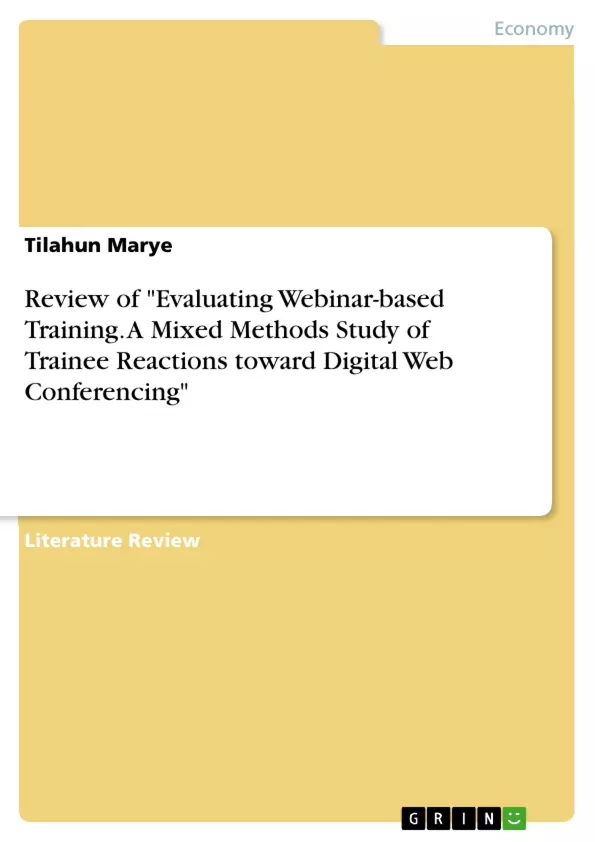This is a review of an article about webinar-based training. The purpose of the study is to evaluate the reactions of training participants toward webinars in order to contribute to the growing body of evidence on digital webinar-based training. Furthermore, the study was designed to estimate satisfaction levels. A certain interest was in investigating how the estimated reactions could be used to produce empirical, evidence-based recommendations for the delivery of webinars in training, adult education and human resource development. The researcher also used mixed methods of research to make the findings widely applicable.
The research is evaluating webinar-based training by applying a mixed approach research methods which employs both qualitative and quantitative approaches to evaluate trainee reactions toward digital web conferencing. It also assesses the reactions of training participants towards digital webinar based trainings. To achieve the objective the researcher participates 419 trainees toward 48 webinars in four content areas like industrial management, supply chain management, early childhood education and mathematics.
Nowadays, human resource management is enhanced by technologies to deliver fast and relatively accurate information on time. Digital technologies became a common tools for the human resources development purpose in general and training in specific. Among multi technological tools, webinar is used for training purposes. Webinar is used to communicate between students and teachers from far places via connected platforms through voice or video communication.
Inhaltsverzeichnis (Table of Contents)
- Introduction
- Purpose of the Study
- Research Methodology
- Quantitative part
- Sampling Frame
- Qualitative Part
- Data collection
- Quantitative part
- Data analysis
- Results and Discussion
- Weakness
- Strength
- Conclusion and Recommendation
- References
Zielsetzung und Themenschwerpunkte (Objectives and Key Themes)
This study aims to evaluate trainee reactions toward webinar-based training, specifically focusing on their satisfaction levels with the delivery method. The researchers utilize mixed methods to gather a comprehensive understanding of participant experiences and to provide evidence-based recommendations for improving webinar-based training delivery. The study further seeks to contribute to the existing body of knowledge on digital webinar-based training in the context of adult education and human resource development.
- Evaluating trainee reactions to webinar-based training
- Assessing satisfaction levels with webinar delivery
- Identifying factors contributing to trainee satisfaction
- Providing evidence-based recommendations for improving webinar delivery
- Contributing to the literature on digital webinar-based training in adult education and human resource development
Zusammenfassung der Kapitel (Chapter Summaries)
- Introduction: This chapter outlines the study's purpose and provides a context for the increasing use of digital technologies in human resource management and training. The authors highlight the growing popularity of webinars as a training tool and the need for research to evaluate their effectiveness.
- Research Methodology: The study uses a mixed-methods approach, combining both quantitative and qualitative data collection and analysis techniques. The researchers describe the sampling frame, data collection methods, and the statistical analyses used. The chapter also details the qualitative part of the study, which involves interviews with a subset of the participants to gather in-depth insights.
- Data analysis: This chapter presents the methods employed for analyzing both the quantitative and qualitative data. The researchers describe the statistical analysis used for the quantitative data, including exploratory factor analysis and analysis of variance. They also outline the qualitative content analysis used to analyze the interview data.
- Results and Discussion: The results of the study are presented and discussed in this chapter. The authors report findings from both the quantitative and qualitative data analysis, highlighting key themes and insights into trainee reactions toward webinar-based training. The chapter also explores potential implications of the findings for future practice and research.
Schlüsselwörter (Keywords)
This research paper examines the effectiveness of webinar-based training by investigating trainee reactions, satisfaction levels, and recommendations for improving delivery. The study focuses on adult education and human resource development, utilizing mixed methods research. Key terms and concepts explored include digital web conferencing, trainee satisfaction, empirical evidence, mixed methods, and recommendations for training delivery.
- Citar trabajo
- Tilahun Marye (Autor), 2021, Review of "Evaluating Webinar-based Training. A Mixed Methods Study of Trainee Reactions toward Digital Web Conferencing", Múnich, GRIN Verlag, https://www.grin.com/document/1259336



